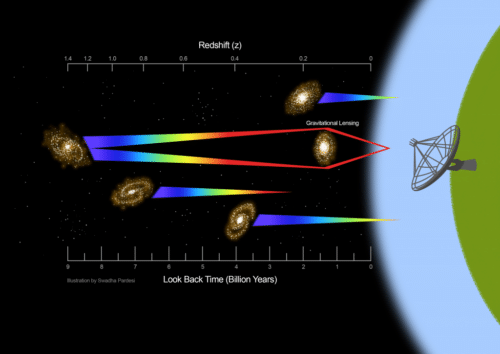Researchers have recorded radio signals originating from atomic hydrogen in distant galaxies using the Giant Metrewave Radio Telescope (GMRT).

The idea of earth being the only planet with life has never been a satisfying thought. In this enormous bundle of stars, planets and energy there might be some other form of life. Maybe more advanced and existing on a different law of nature. Our exploration for such knowledge has been in progress for over centuries. We require technology which can take us far enough to meet our “distant cousins”.
Astronomers from McGill University in Canada and the Indian Institute of Science (IISc) in Bengaluru have used data from the Giant Metrewave Radio Telescope (GMRT) in Pune to detect a radio signal originating from atomic hydrogen in an extremely distant galaxy. The astronomical distance over which such a signal has been picked up is the largest so far by a large margin. This is also the first confirmed detection of strong lensing of 21 cm emission from a galaxy.
Atomic hydrogen is the basic fuel required for star formation in a galaxy. When hot ionised gas from the surrounding medium of a galaxy falls onto the galaxy, the gas cools and forms atomic hydrogen, which then becomes molecular hydrogen, and eventually leads to the formation of stars. Therefore, understanding the evolution of galaxies over cosmic time requires tracing the evolution of neutral gas at different cosmological epochs.
Using GMRT data researchers have detected a radio signal from atomic hydrogen in a distant galaxy at redshift z=1.29. This detection was made possible by a phenomenon called gravitational lensing, in which the light emitted by the source is bent due to the presence of another massive body, such as an early type elliptical galaxy, between the target galaxy and the observer, effectively resulting in the “magnification” of the signal.
One interesting thing observed by the researchers is that the atomic hydrogen mass of this particular galaxy is almost twice as high as its stellar mass. These results demonstrate the feasibility of observing atomic gas from galaxies at cosmological distances in similar lensed systems with a modest amount of observing time. It also opens up exciting new possibilities for probing the cosmic evolution of neutral gas with existing and upcoming low-frequency radio telescopes in the near future.
Reference : Chakraborty A, Roy N, Detection of H I 21 cm emission from a strongly lensed galaxy at z ∼ 1.3, Monthly Notices of the Royal Astronomical Society (2023), Volume 519, Issue 3. https://doi.org/10.1093/mnras/stac3696








